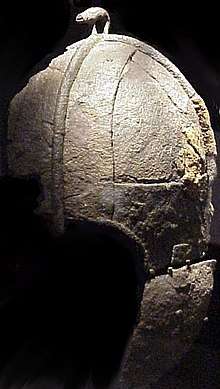Ian Meadows (archaeologist)
Ian D. Meadows is a British archaeologist. He has worked in archaeology for some 40 years, including as a Senior Project Officer at Northamptonshire Archaeology from 1992 to 2014.[1] During that time he excavated a number of large quarries in England and Wales,[1] and excavated the boar-crested Anglo-Saxon Pioneer Helmet in addition to discovering the first definitive evidence for viticulture in Roman Britain.[2] He has also worked for the Museum of London Archaeology, and has taught archaeology and landscape history for Cambridge University, Anglia Ruskin University, the University of Bath, and the Workers' Educational Association.[1][3]
Career

Meadows has worked in archaeology for approximately 40 years.[1][3] From 1992 to 2014 he worked with Northamptonshire Archaeology as Senior Project Officer, during which time he directed many projects, particularly the excavations of large landscapes in English and Welsh quarries.[1] Starting in about 1993 Meadows began digging in a gravel pit in Wollaston, Northamptonshire, ultimately leading to both the discovery of the first definitive evidence of viticulture from Roman Britain,[4][5] and the unearthing of the Pioneer Helmet, only the fourth Anglo-Saxon helmet to be found.[2][6]
In 1996, while leading a team with Tony Brown of the University of Exeter's School of Geography and Archaeology, Meadows discovered the first evidence for viticulture from Roman Britain.[4][7][8] The find followed the excavation of a series of farms from the Iron and Roman ages,[9] and was soon followed by the discovery of vineyards in the Nene Valley.[10][11] By 1999 Meadows had found evidence of seven vineyards: four in Northamptonshire, one in Cambridgeshire, one in Lincolnshire and one in Buckinghamshire.[10][11] One site alone had four miles of trenches, enough to produce about 10,000 litres of wine annually.[10][11] The seven vineyards covered a combined 30 acres, suggesting to Meadows that "research may yet reveal that Britain was a major wine producer in ancient times."[10]
The year after discovering the Roman vineyards, in 1997 Meadows discovered the Anglo-Saxon Pioneer Helmet.[6] Also found in Wollaston, it was part of the inhumation of a high-status Anglo-Saxon man, and was found with a pattern welded sword and a hanging bowl.[2] News of the find made newspapers as far away as Australia and New Zealand,[12] for the helmet was only the fourth contemporaneous example to be discovered,[6] coming after those from Benty Grange, Sutton Hoo, and York,[13] and before two subsequent discoveries from Shorwell and Staffordshire.[14]
As of 2016, Meadows is leading the excavations at Chester Farm, a walled Roman town with 10,000 years of history.[3] It has evidence dating back to the Mesolithic, Iron and Medieval ages, as well as farm buildings from the 17th century.[3]
Publications
- Meadows, Ian (November 1996). "Wollaston: The Nene Valley, A British Moselle?". Current Archaeology. Current Publishing. 13 (150): 212–215. ISSN 0011-3212.
- Brown, Anthony G.; Meadows, Ian (1996–97). "Environmental analysis of a Neolithic/early Bronze Age palaeochannel from Turnells Mill Lane, Wellingborough in the Nene valley". Northamptonshire Archaeology. Northamptonshire Archaeological Society. 27: 185–191.
- Meadows, Ian (1996–97). "The Pioneer Helmet". Northamptonshire Archaeology. Northamptonshire Archaeological Society. 27: 191–193.
- Webster, Leslie & Meadows, Ian (July–August 1997). "Discovery of Anglo-Saxon Helmet helmet with Boar Crest". Minerva. 8 (4): 3–5.
- Meadows, Ian (September 1997). "Wollaston: The 'Pioneer' Burial". Current Archaeology. Current Publishing. 13 (154): 391–395. ISSN 0011-3212.
- Meadows, Ian (Autumn–Winter 1997). "The Pioneer Helmet: A Dark-Age Princely Burial from Northamptonshire". Medieval Life. Medieval Life Publications (8): 2–4. ISSN 1357-6291.
- Brown, Anthony G.; Meadows, Ian; Turner, Simon D. & Mattingly, David (December 2001). "Roman Vineyards in Britain: Stratigraphic and Palynological Data from Wollaston in the Nene Valley, England". Antiquity. 75 (290): 745–757. doi:10.1017/S0003598X00089250.

- Meadows, Ian (March 2004). "An Anglian Warrior Burial from Wollaston, Northamptonshire". Northamptonshire Archaeology Reports (2010 digital ed.). Northamptonshire County Council. 10 (110).
- Meadows, Ian (Winter 2006). "Environmental sampling and the evolution of the Nene Valley" (PDF). The Archaeologist. Institute of Field Archaeologists (59): 15.

References
- 1 2 3 4 5 AJJ.
- 1 2 3 Read 2006, p. 38.
- 1 2 3 4 Chester Farm.
- 1 2 Meadows 1996, pp. 212, 215.
- ↑ Brown et al. 2001, p. 745.
- 1 2 3 Saraceni 1997.
- ↑ Scott 2011a.
- ↑ Scott 2011b.
- ↑ Meadows 1996, pp. 212.
- 1 2 3 4 Keys 1999.
- 1 2 3 Schuster 2000.
- ↑ Meadows 1997, p. 391.
- ↑ Read 2006, p. 39.
- ↑ Butterworth et al. 2016, p. 41 n.27.
Bibliography
- Butterworth, Jenni; Fregni, Giovanna; Fuller, Kayleigh & Greaves, Pieta (2016). "The importance of multidisciplinary work within archaeological conservation projects: assembly of the Staffordshire Hoard die-impressed sheets". Journal of the Institute of Conservation. Institute of Conservation. 39 (1): 29–43. doi:10.1080/19455224.2016.1155071.
- "Ian Meadows". Chester Farm. Northamptonshire County Council. Retrieved 16 May 2017.

- Keys, David (16 November 1999). "Veni, Vidi, Viticulture – Remains of Roman Vineyards Found in UK". The Independent. Retrieved 6 May 2017.

- Read, Anthony (2006). "The conservation of the Wollaston Anglian helmet". In Smith, Robert Douglas. Make all sure: The conservation and restoration of arms and armour. Leeds: Basiliscoe Press. pp. 38–43. ISBN 0-9551622-0-3.
- Saraceni, Jessica E. (November–December 1997). "Saxon Helmet Restored". Archaeology. Archaeological Institute of America. 50 (6). ISSN 0003-8113. Retrieved 20 February 2017.

- Schuster, Angela M. H. (March–April 2000). "Wine Lover's Guide to Ancient Britain". Archaeology. Archaeological Institute of America. 53 (2). ISSN 0003-8113. Retrieved 6 May 2018.

- Scott, Chris (11 February 2011a). "Ian Meadows on Ancient English Wine Drinking". Thirty Fifty. Retrieved 6 May 2018.

- Scott, Chris (17 February 2011b). "UK Wine Show 245 Ian Meadows on Roman Vineyards in the UK". Thirty Fifty. Retrieved 6 May 2018.

- "Team: Ian Meadows". Andrew Josephs Associates. Archived from the original on 24 April 2017.
